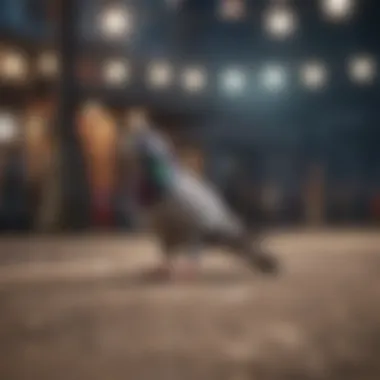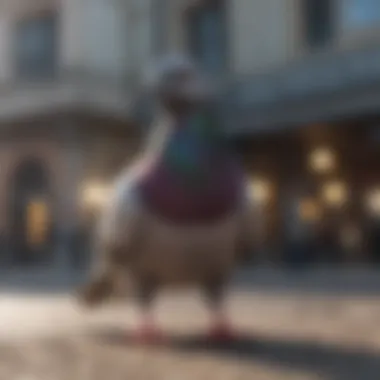Efficient Anti-Pigeon Solutions: A Comprehensive Guide for Urban Environments


Equipment and Gear
When it comes to combating the pervasive presence of pigeons in urban settings, having the right equipment and gear plays a pivotal role in implementing effective anti-pigeon solutions. One of the essential pieces of gear for deterring pigeons is a reliable bird spike system, which acts as a physical barrier to prevent these nuisance birds from perching or roosting on buildings and structures. Top brands like AVISHOCK™ and Bird Barrier offer cutting-edge bird spike products designed to blend seamlessly with different architectural styles while providing long-lasting bird control solutions. These bird spikes are crafted from durable materials such as stainless steel or high-grade plastic, ensuring durability and effectiveness in deterring pigeons.
In addition to bird spike systems, another vital equipment in the arsenal of anti-pigeon solutions is the bird netting. Bird netting serves as a versatile and humane method to exclude pigeons from areas such as balconies, rooftops, and courtyards. Brands like StealthNet® and Bird-X offer premium bird netting solutions that are UV stabilized for long-term outdoor use and are available in various mesh sizes to suit different applications. The bird netting is not only effective in preventing pigeons from accessing specific areas but also ensures the safety of both the birds and the environment.
To maintain the efficacy of the anti-pigeon equipment and gear, regular maintenance is crucial. Inspecting bird spike systems for any signs of wear and tear, cleaning bird netting to remove debris and nesting materials, and ensuring that all components are properly installed are essential steps in upholding the integrity of the anti-pigeon solutions. Moreover, staying updated on new advancements in anti-pigeon equipment, such as motion-activated deterrents or sound devices, can further enhance the effectiveness of pigeon control measures.
Introduction to Pigeon Control
Understanding the crucial importance of pigeon control sets the foundation for this comprehensive article. In urban environments, the presence of pigeons poses significant challenges to cleanliness and aesthetics. By delving into effective strategies and solutions as highlighted in this guide, readers will gain valuable insights into combating the pigeon menace. The relevance of pigeon control cannot be overstated, especially for homeowners, business owners, and city planners seeking to protect their properties and public spaces.
Understanding the Pigeon Problem
The Proliferation of Pigeons in Urban Areas
Discussing the proliferation of pigeons in urban areas sheds light on a pressing issue that significantly impacts the urban landscape. The increasing numbers of pigeons have become a common sight, leading to various complications in maintaining cleanliness and structural integrity in buildings. Despite their adaptability, pigeons' overpopulation necessitates proactive management to curb their adverse effects. While their presence may seem innocuous at first glance, the unchecked growth of pigeon colonies can swiftly escalate into a serious concern for urban areas, highlighting the need for effective pigeon control measures.
Impact of Pigeons on Buildings and Public Spaces
Exploring the impact of pigeons on buildings and public spaces unveils the profound consequences of unchecked pigeon activities. Pigeons, through their roosting and nesting habits, can inflict damage to structures, compromising their safety and aesthetics. Moreover, the droppings of pigeons pose health hazards and mar the visual appeal of public spaces, necessitating urgent intervention. Understanding the extent of damage caused by pigeons underscores the imperative of implementing tailored solutions to mitigate their negative impact effectively.
Why Traditional Methods Fall Short
Lack of Long-Term Effectiveness
Examining the limitations of traditional pigeon control methods exposes their inherent shortcomings concerning long-term efficacy. Conventional approaches like scare tactics or physical barriers often provide temporary relief but fail to address the root cause of the issue comprehensively. The transient nature of these methods underscores the need for sustainable pigeon control solutions that offer lasting protection against avian nuisances.
Issues with Inhumane Bird Control
Identifying the deficiencies associated with inhumane bird control practices underscores ethical considerations in addressing the pigeon problem. Inhumane methods such as poisoning or trapping raise significant welfare concerns for the targeted birds and other unintended wildlife casualties. Recognizing these ethical dilemmas mandates a shift towards compassionate and humane approaches that safeguard not only properties but also the well-being of all living beings involved.


The Need for Innovative Anti-Pigeon Solutions
Advancements in Pigeon Deterrent Technologies
Exploring the latest advancements in pigeon deterrent technologies elucidates the evolution of solutions tailored to modern challenges. From sophisticated laser systems to motion-activated repellents, innovative technologies offer a proactive and efficient means of deterring pigeons effectively. The integration of advanced features like AI-powered sensors and automated response mechanisms enhances the precision and effectiveness of pigeon control measures, marking a significant leap forward in urban pest management.
Embracing Humane and Eco-Friendly Approaches
Advocating for humane and eco-friendly approaches signifies a paradigm shift towards sustainable pest control practices. By prioritizing non-lethal methods and environmental compatibility, these approaches strike a balance between effective bird management and ecosystem preservation. Embracing humane solutions not only aligns with ethical standards but also ensures a harmonious coexistence between humans and wildlife, fostering a healthier and more compassionate urban environment.
Humane Anti-Pigeon Measures
At the core of our discourse on anti-pigeon strategies lies the paramount significance of humane anti-pigeon measures. In this comprehensive narrative, we delve into the essential elements, benefits, and considerations that encapsulate the realm of humane anti-pigeon measures. Understanding the vitality of incorporating humane practices in pigeon control is indispensable for fostering a harmonious coexistence between humans and avian species, particularly in densely populated urban settings where conflict often arises.
Physical Deterrents
Spikes and Bird Netting
Unveiling a critical facet of physical deterrents, spikes, and bird netting manifest as stalwart guardians against avian intrusions. The resilience of spikes and bird netting in thwarting pigeon congregations underscores their pivotal role in enhancing the efficacy of our anti-pigeon endeavors. A striking characteristic of spikes and bird netting is their non-invasive nature, which actively dissuades pigeons without causing harm. This non-destructive approach not only safeguards buildings and public spaces but also upholds the essence of humane bird control methods, aligning seamlessly with the overarching ethos of our discourse.
Delving deeper into the nuances of spikes and bird netting, their unrivaled advantage lies in the comprehensive coverage they provide, offering a lasting solution to pigeon woes. However, a meticulous evaluation also prompts us to acknowledge potential drawbacks such as maintenance requirements and occasional visual obtrusions, factors that are pivotal in shaping our decision-making process regarding their installation.
Gel Repellents and Shock Tracks
Now transitioning to the realm of gel repellents and shock tracks, we encounter a paradigm shift in the domain of pigeon deterrence. The adhesive nature of gel repellents coupled with the strategic placement of shock tracks embodies a proactive approach to pigeon control, constituting these methods as stalwarts in our anti-pigeon arsenal. A standout feature of gel repellents and shock tracks is their dual functionality, not only deterring pigeons but also instilling a sense of caution within avian inhabitants, thus ensuring a sustainable deterrent mechanism.
Nevertheless, an introspective analysis also necessitates a consideration of the limitations associated with gel repellents and shock tracks. While excelling in effectiveness, these solutions may entail maintenance obligations and periodic replenishments, elements that warrant judicious appraisal for optimal integration within our anti-pigeon directive.
Visual and Sound-based Deterrents
Predator Decoys and Reflective Objects
Venturing into the realm of visual and sound-based pigeon deterrents unfurls the discourse on predator decoys and reflective objects, emblematic of a proactive stance against avian antagonists. The conspicuity of such deterrents, accentuating the element of threat perception among pigeons, signifies their instrumental role in shaping avian behavior. The strategic deployment of predator decoys and reflective objects serves as a formidable barrier, dissuading pigeons through visual cues that emulate imminent danger.


In evaluating the prowess of predator decoys and reflective objects, their unassuming yet formidable presence emerges as a pivotal advantage, instigating a flight response among pigeons while maintaining environmental aesthetics. However, a nuanced reflection also unveils potential drawbacks, including susceptibility to environmental conditions and the necessity for strategic repositioning to uphold their efficacy over time.
Ultrasonic Devices and Bird Distress Calls
Transitioning towards the technological frontier of pigeon deterrents elucidates the integration of ultrasonic devices and bird distress calls. Harnessing the power of sonic intervention, ultrasonic devices and bird distress calls project an aura of avian hostility, fostering a hostile environment for pigeons. A defining characteristic of these deterrents lies in their subtlety, emanating frequencies imperceptible to human ears yet disruptive to avian sensibilities, thereby constituting a strategic tool in our anti-pigeon endeavor.
Despite the remarkable efficacy of ultrasonic devices and bird distress calls, prudent consideration of their limitations is imperative. Factors such as range constraints and potential habituation among pigeon populations underscore the necessity for a judicious combination of strategies to maximize deterrence capabilities and sustain long-term pigeon control.
You have now gained a comprehensive insight into the realm of humane anti-pigeon measures, juxtaposed with the intricate nuances of physical, visual, and sound-based deterrents. By cultivating an in-depth understanding of these methodologies, you are poised to navigate the labyrinth of pigeon control with efficacy and finesse.
Technological Innovations in Pigeon Control
AI-Powered Bird Control Systems
Automated Deterrents and Monitoring
An essential aspect of AI-Powered Bird Control Systems is the integration of Automated Deterrents and Monitoring functionalities. These features enable real-time tracking and deterrent deployment based on intelligent algorithms and data analysis. The key characteristic of Automated Deterrents and Monitoring lies in the ability to provide continuous oversight of pigeon activity while autonomously triggering deterrent measures when necessary. This automated approach not only increases the efficiency of pigeon control efforts but also minimizes the need for manual intervention. The unique feature of Automated Deterrents and Monitoring is its adaptability to varying pigeon behaviors, ensuring a tailored response to specific threats. While its advantages include improved response time and resource optimization, potential disadvantages may arise from initial setup complexities.
Behavior-based Solutions
Within the realm of AI-Powered Bird Control Systems, Behavior-based Solutions offer a proactive approach to pigeon management. By analyzing patterns in pigeon behavior, these solutions can anticipate potential roosting or nesting locations, thereby preemptively deterring pigeons before conflicts arise. The key characteristic of Behavior-based Solutions is their predictive capabilities, allowing for preemptive actions that disrupt pigeon activities effectively. This proactive stance makes Behavior-based Solutions a popular choice for mitigating long-term pigeon issues within urban settings. The unique feature of this approach is its ability to adapt to evolving pigeon behaviors, ensuring sustained deterrence over time. While advantages include long-term effectiveness and reduced reliance on reactive measures, challenges may emerge in accurately predicting complex avian behaviors.
Drone-based Anti-Pigeon Solutions
Aerial Surveillance and Dispersal
An integral aspect of Drone-based Anti-Pigeon Solutions is Aerial Surveillance and Dispersal methods. By leveraging drones for monitoring and dispersal activities, this approach offers a bird's eye view of urban environments, enabling targeted interventions where pigeons congregate. The key characteristic of Aerial Surveillance and Dispersal is its ability to cover large areas efficiently, providing comprehensive insights into pigeon hotspots and facilitating precise dispersal tactics. This targeted approach enhances the efficacy of pigeon control initiatives by focusing efforts on high-impact areas. The unique feature of Aerial Surveillance and Dispersal is its versatility in adapting to diverse urban landscapes, making it a valuable tool for precision control strategies. While its advantages lie in enhanced scalability and targeted interventions, challenges may be encountered in airspace regulations and technology maintenance.
Remote Monitoring and Management
Complementing Aerial Surveillance is the role of Remote Monitoring and Management in Drone-based Anti-Pigeon Solutions. This component enables real-time oversight of drone operations and data analysis, allowing for swift decision-making and adaptive strategies. The key characteristic of Remote Monitoring and Management is its centralization of control, simplifying operational coordination and ensuring timely responsiveness to evolving pigeon behaviors. This centralized approach streamlines management efforts and enhances the overall efficiency of drone-based interventions. The unique feature of Remote Monitoring and Management is its seamless integration with existing control systems, fostering synergy between manual and automated processes. While advantages encompass increased operational efficiency and data-driven insights, potential drawbacks may stem from connectivity issues and cybersecurity concerns.
Integrated Approaches for Pigeon Management


Integrated approaches for pigeon management play a pivotal role in addressing the persistent issue of pigeon infestation in urban environments. By combining physical and technological solutions, a comprehensive defense system can be established to effectively deter pigeons and maintain clean surroundings. The synergy between traditional deterrent methods and innovative technologies offers a multi-faceted approach to pigeon control that enhances the overall efficacy of the management strategies. Integrated solutions consider the unique challenges posed by pigeon populations and ensure a proactive and sustainable method of addressing pigeon-related concerns.
Combining Physical and Technological Solutions
Multi-Layered Defense Systems
Multi-layered defense systems form a critical component of integrated pigeon management approaches. These systems involve the strategic combination of physical barriers like spikes and nets with cutting-edge technological solutions such as AI-powered deterrents and monitoring systems. The key characteristic of multi-layered defense systems lies in their ability to create multiple barriers that discourage pigeons from roosting or nesting in specific areas. This approach is deemed beneficial in this article due to its comprehensive coverage and adaptability to various urban settings. The unique feature of multi-layered defense systems is their layered protection, which addresses pigeon behavior from both a physical and psychological standpoint. While providing robust protection, these systems may require regular maintenance, which can be a drawback in this article.
Customized Anti-Pigeon Strategies
Customized anti-pigeon strategies offer a personalized approach to pigeon management tailored to the specific requirements of each urban area. By analyzing local conditions, infrastructure, and pigeon behavior patterns, customized strategies aim to implement targeted solutions that address the root causes of pigeon-related issues. The key characteristic of customized anti-pigeon strategies is their flexibility and adaptability to diverse environmental factors, making them a preferred choice for this article. The unique feature of customized strategies lies in their ability to incorporate feedback from ongoing monitoring and adjust control measures accordingly, ensuring optimal results. While effective, these strategies may require a higher initial investment and ongoing evaluation, which can be considered as potential disadvantages in this article.
Collaborative Urban Planning for Pigeon Control
City-wide Initiatives and Regulations
City-wide initiatives and regulations serve as fundamental pillars in the collaborative effort towards effective pigeon control in urban areas. These initiatives encompass policies and guidelines that govern pigeon management practices across an entire city or region, ensuring a standardized and coordinated approach to addressing pigeon-related challenges. The key characteristic of city-wide initiatives is their ability to create a harmonized framework that promotes proactive and unified actions against pigeon infestation. In this article, city-wide initiatives are hailed as a beneficial choice for their scalability and impact on large-scale pigeon control efforts. The unique feature of such initiatives lies in their capacity to mobilize resources and expertise on a city-wide scale, fostering collective responsibility and coordination. However, challenges may arise in enforcing regulations and ensuring compliance across diverse urban landscapes, reflecting potential disadvantages within this article.
Consultation with Experts and Stakeholders
Consultation with experts and stakeholders is essential in developing comprehensive and sustainable pigeon control strategies within urban settings. By engaging with avian specialists, urban planners, and community members, valuable insights can be gained regarding effective pigeon management practices and their implications for different stakeholders. The key characteristic of consultation lies in its ability to leverage diverse expertise and perspectives to formulate holistic approaches to pigeon control. In this article, consultation with experts and stakeholders is viewed as a valuable choice for its inclusivity and collaborative nature, ensuring that all relevant parties are involved in decision-making processes. The unique feature of such consultations is the synergy between scientific knowledge and practical experience, leading to well-informed and context-specific pigeon management strategies. However, challenges may arise in balancing various interests and perspectives, underscoring potential disadvantages in this article.
Conclusion: Ensuring Pigeon-Free Environments
As we conclude this in-depth exploration of anti-pigeon solutions, the importance of creating pigeon-free environments cannot be overstated. Maintaining cleanliness, aesthetics, and structural integrity in urban and suburban spaces is imperative for various stakeholders ranging from homeowners to city planners. The proliferation of pigeons in urban areas presents significant challenges, requiring innovative strategies to mitigate their impact effectively.
The comprehensive approach outlined in this article emphasizes the significance of sustainable practices and ongoing maintenance in achieving and sustaining pigeon-free environments. By integrating humane deterrents with cutting-edge technologies, property owners and urban planners can proactively address the pigeon problem and uphold standards of cleanliness and hygiene.
Sustainable Practices and Ongoing Maintenance
Regular Inspections and Upkeep:
Purposing regular inspections and upkeep plays a pivotal role in the anti-pigeon strategy unveiled in this guide. By conducting systematic inspections, property owners can detect potential pigeon entry points and areas susceptible to roosting. Continual upkeep ensures the efficacy and longevity of installed deterrents, maintaining their functionality and deterring pigeons effectively.
Environmental Considerations and Impact Assessment:
Embedding environmental considerations and impact assessments into the anti-pigeon framework outlined in this article is paramount. Understanding the ecological implications of pigeon control measures is essential for minimizing adverse effects on non-target species and the surrounding ecosystem. Assessing the environmental impact allows for the implementation of sustainable practices that prioritize biodiversity conservation while effectively managing pigeon populations.
The nuanced approach to sustainable practices and ongoing maintenance elucidates the multifaceted nature of pigeon control, emphasizing the harmonization of effective deterrence methods with ecological sensibility. By actively engaging in regular inspections, upkeep, and environmental assessments, stakeholders can foster pigeon-free environments that embody both functionality and environmental conscientiousness.















